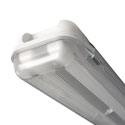Power factor is a lesser known specification in the world of lighting. It measures how efficiently power is used in an AC circuit, and is a closely scrutinised area of LED and fluorescent lighting. Despite being vastly more energy efficient than filament lighting, these newer technologies have a naturally low power factor. This may seem trivial when compared to their substantial benefits, but has, regardless, been subject to EU regulations in recent years.
Energy suppliers surcharge commercial customers for use of low power factor equipment. This is openly itemised as either a power factor charge or reactive power charge, and billed in units of kVAr. Large, complex buildings with numerous luminaires will plainly be more affected. Low power factor also reduces the number of fittings installable on a lighting circuit.
By choosing energy efficient lighting with a high power factor, energy savings are truly maximised, meaning you should not be hit with such a surcharge. To go straight to our high power factor products click here. Alterntively, read on to really understand what the power factor is all about…
The power factor calculation
Power factor is calculated by dividing the active power used (in watts) by the apparent power drawn from the power grid (in volt-amps, or VA). A unitless number between 0.0 and 1.0 is used, with 1.0 representing 100% unity (i.e. 1 volt-amp = 1 watt).
Circuits containing only heating elements have a 1.0 power factor. This includes the resistive circuit of an incandescent lamp, where current increases and decreases proportionately with voltage (meaning the current and voltage are ‘in phase’).
LED and fluorescent circuits have inductive or capacitive elements, and never have a 1.0 power factor. Voltage and current are always out of phase to some degree, with only the in-phase portions producing real work. Power factor correction (PFC) can be installed to bring voltage and current more closely into phase. Any unused power is called reactive power.
Power factor charges
Commercial customers are surcharged for reactive power in units of kVAr. Suppliers apply a power factor threshold of between 0.85 and 0.95, above which there is no charge. Domestic users are never billed for reactive power.
Examples:
- A 60W incandescent lamp draws 60 volt-amps (VA) from the power grid, thus has a 1.0 power factor. All of its supplied power produces work.
- A 5W LED lamp with a 0.5 power factor will draw 10 volt-amps (VA) from the grid. It is hugely more energy-efficient than the incandescent lamp, but only converts 50% of its drawn power into work (watts).
This does not mean the LED lamp uses 10W of power, since reactive power is returned rather than consumed. However, low power factor increases power transmission losses, voltage dips, distribution costs, and carbon emissions. The grid is forced to supply a higher power level than is required at the load.
Standards and the future
From September 1st 2013, EU regulation 1194/2012 came into force:
- LED lamps between 2W and 5W require a minimum 0.4 power factor.
- LED lamps over 5W and up to 25W require a minimum 0.5 power factor.
- LED lamps over 25W require a minimum 0.9 power factor.
- CFLs with integrated ballasts (retrofit CFLs) require a minimum 0.5 power factor up to 25W, and 0.9 above.
Arguments against power factor correction in lamps include: increases in cost, materials, weight, heat, as well as a minor decrease in efficiency.
In 2010, Once Innovations revealed the SCD conditioning circuit for AC LEDs, improving power factor, distortion, and luminous efficacy, whilst adding less weight, volume, and parts than existing solutions. Such technology is likely to be more viable as LED prices decrease.
HPF Products
If you’re billed for reactive power, high power factor (HPF) lamps and luminaires may help reduce these charges. Lyco sells a variety of HPF products, including:
The Carina LED Semi Flush has a 0.93 power factor. An IP65 rating means you can install this light almost anywhere, including outdoors or in bathrooms. This versatile luminaire is useful in many commercial or residential applications.
A great recessed fitting for many commercial uses is the Eternity LED Downlight which can be configured for non-maintained or maintained operation. Long-lasting LEDs are integrated, with an expected 35,000 hour lifespan.
Offering numerous advantages over fluorescent counterparts, the Robus Vulcan LED Batten has a 0.95 power factor. This tough fitting is ideal for industrial applications, including car parks, corridors, factories, farm buildings, sheds, and garages.
For offices, schools, and hospitals, the LED Light Panel offers many benefits. It is neat, hygienic, and superbly energy efficient. This top-quality luminaire has a minimum 0.9 power factor.
Hopefully the above products and information will help you avoid any future power factor surcharges. If you jumped straight to the products and now want to see how the power factor is calculated and the subsequent charges click here.
For more useful advice and information take a look at our Lighting Advice section.

Andrew Evangelidis Head of Buying
Andrew is an experienced buying professional who takes an entrepreneurial approach to identify new lighting solutions and ensure Lyco have first-to-market ranges for our customers. Having previously worked for well known brands such as Wickes, Carphone Warehouse and Toys R Us, Andrew has now turned his hand to sourcing commercial lighting and ensure our customers receive top brand quality products at marketing leading prices. He manages a team of commercial and decorative buyers who travel the world finding new products that our customers don’t even know they need yet.







